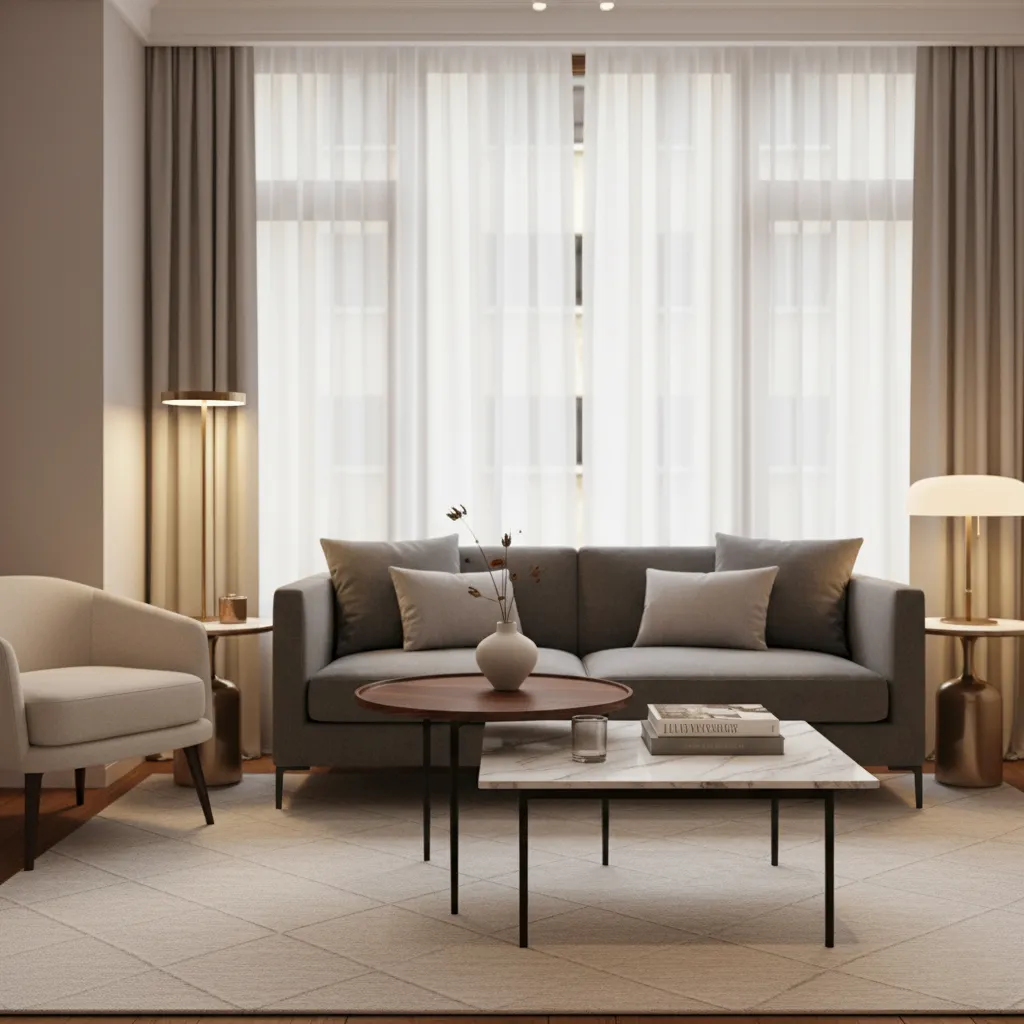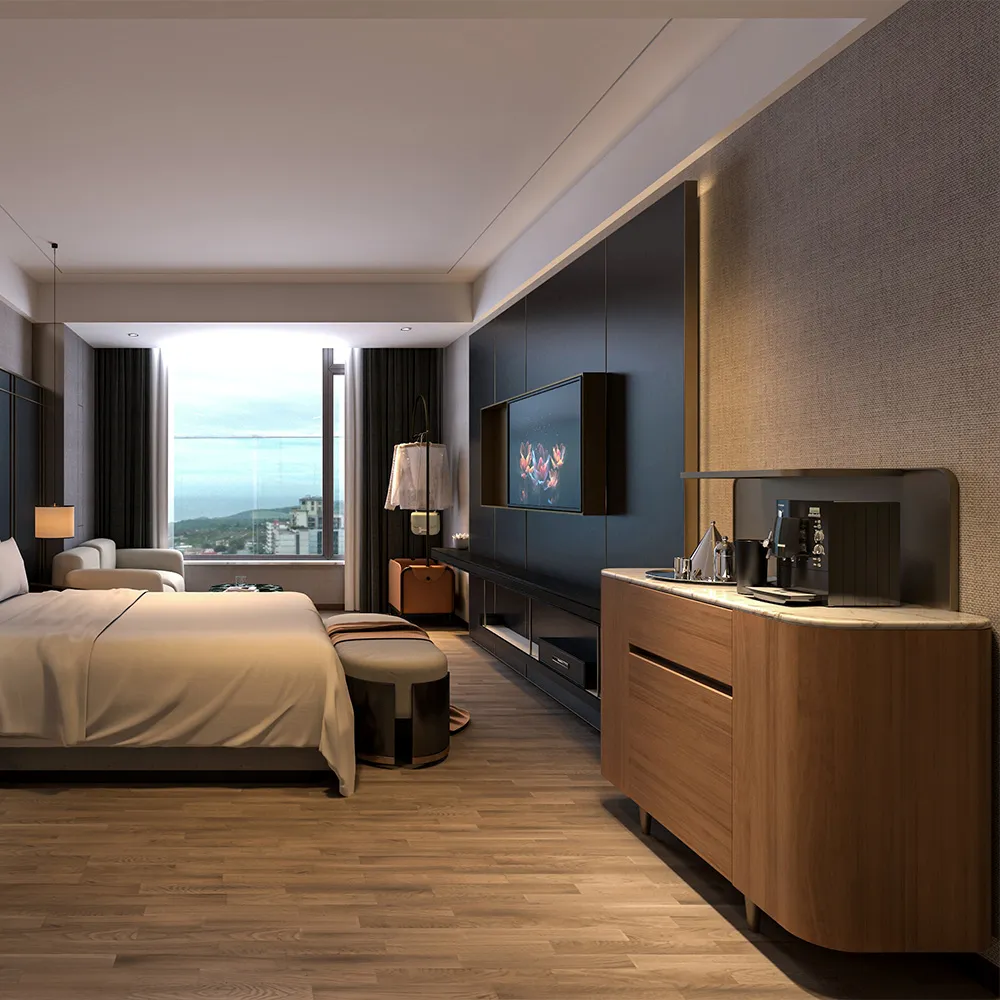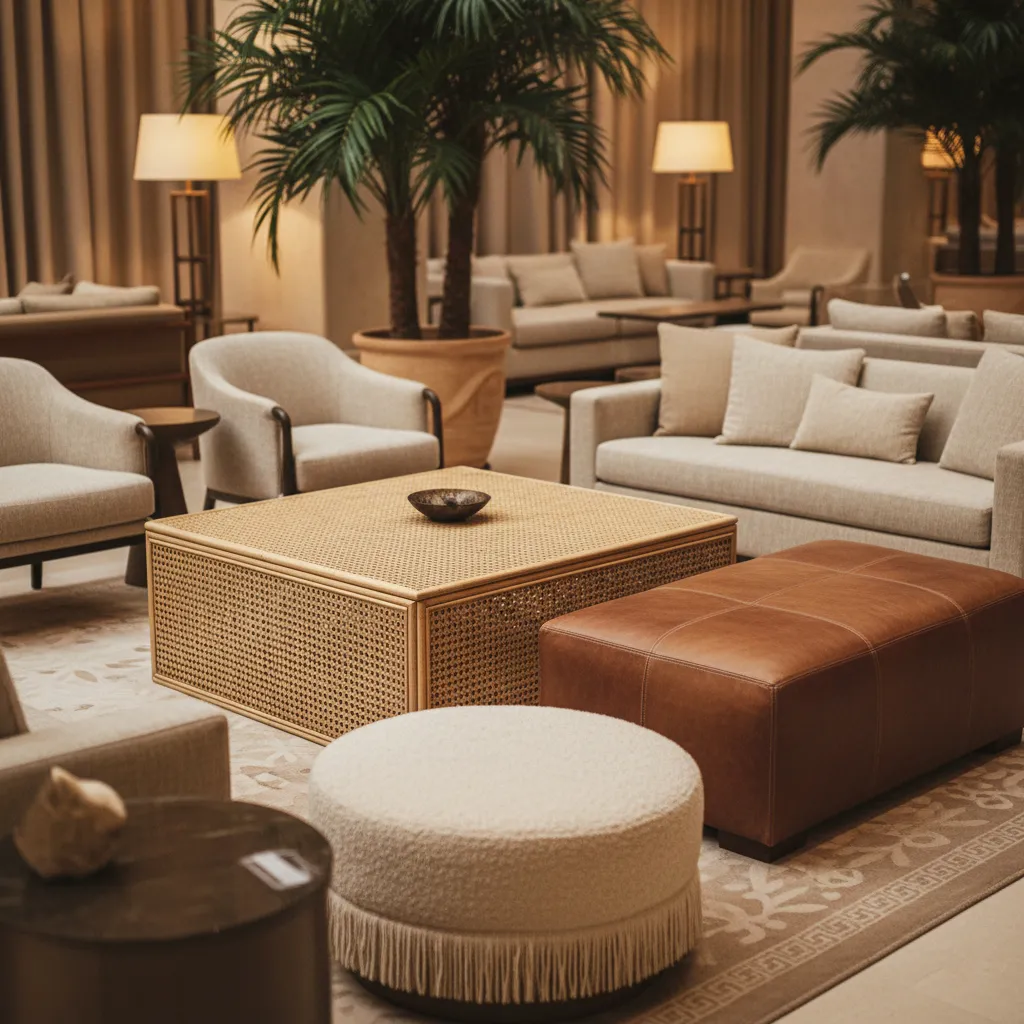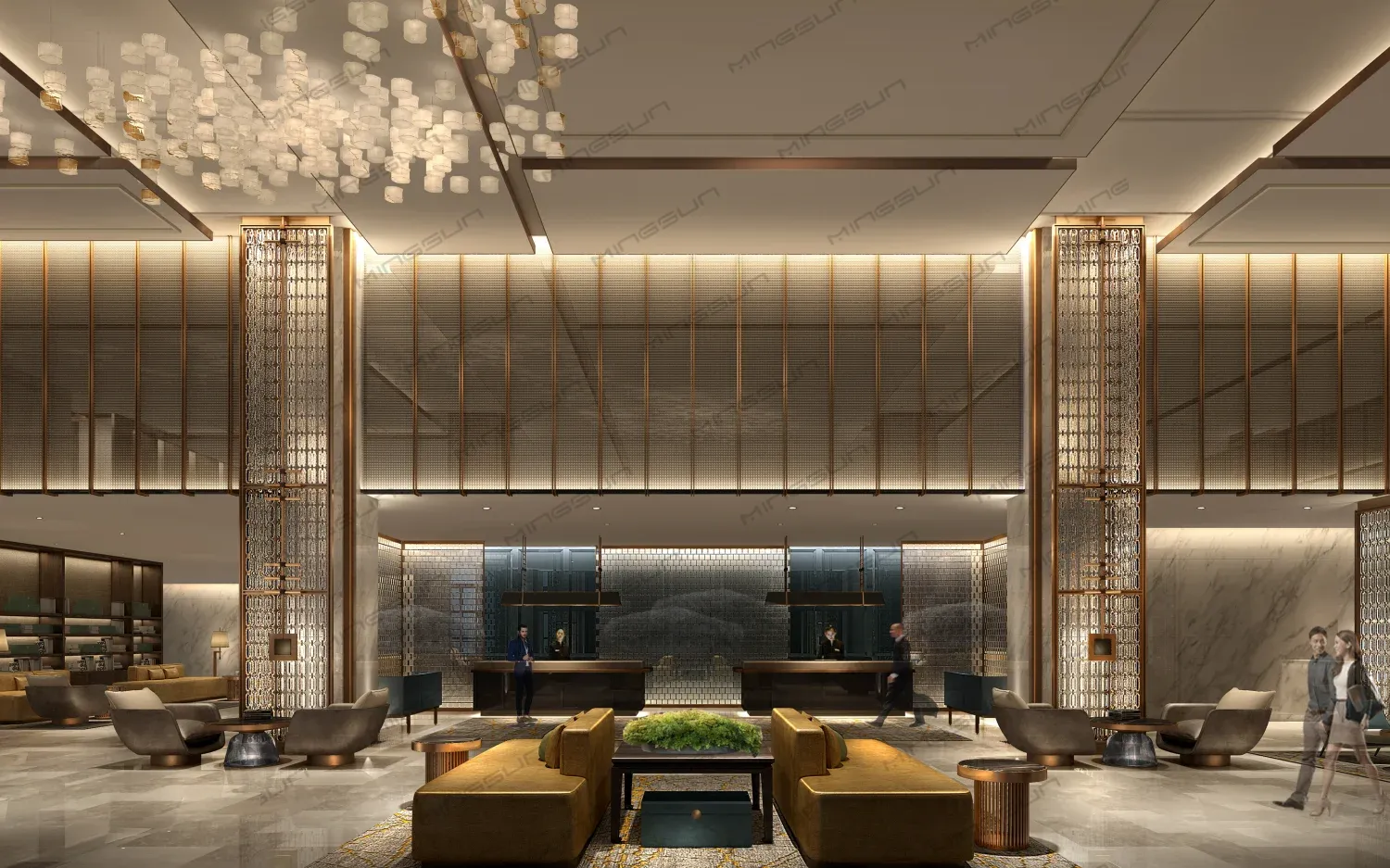How Much Do You Really Know About Hotel Interior Design?
Great hotel interior design balances beauty, comfort, and purpose. In this article, we explore the fundamental components of effective hospitality design and what modern travelers expect. You’ll also discover upcoming industry trends and expert considerations for future-ready hotels.

- Introduction
- Why Hotel Interior Design Matters in Today’s Hospitality Industry
- Key Elements That Shape Hotel Interior Design
- 1. Space Planning and Functional Zoning
- 2. Material Selection and Durability
- 3. Consistent Brand Storytelling
- 4. Comfort and Sensory Experience
- The Role of Furniture in Hotel Interior Design
- Guest Room Furniture Essentials
- Public Space Furniture
- How Color and Lighting Influence Guest Experiences
- Color Psychology in Hospitality Design
- Lighting Layering Techniques
- Hotel Lobby Design: The First Impression That Sets the Tone
- Essential Lobby Design Components
- The Experience-Driven Lobby Trend
- Technology Integration in Hotel Room Design Layout
- Key Technology Features in Modern Hotel Rooms
- Designing for Tech-Aware Guests
- Sustainable and Eco-Friendly Practices in Hotel Interiors
- Eco-Friendly Material Choices
- Energy-Efficient Design Strategies
- Custom Hotel Interior Design Solutions for Unique Properties
- Customization Areas
- Common Mistakes to Avoid in Hotel Interior Design
- What’s Next? Key Hotel Interior Design Trends Shaping 2026
- Conclusion
— A Comprehensive Expert Guide for Hospitality Professionals
Introduction
Hotel interior design is about more than just making a space look good. In today's highly competitive hospitality sector, every detail, such as the design of the seating area in the lobby or the interior design of the hotel rooms, influences guests' perceptions of comfort, service quality, and brand value. Hotel interior design has become one of the most strategic investments for modern hotels, as travelers are interested in individual experiences, aesthetics, and functional comfort.
Whether you are designing a boutique hotel, a city business property, or a luxury resort, it is important to understand the fundamentals and current trends in hotel design. Professional hospitality design is no longer just about aesthetic value. It incorporates psychology, brand narration, effective space planning, sustainability, and technology-based experiences. This article provides an in-depth exploration of the key elements of hotel interior design and the factors that influence the guest experience, both now and in the future.
Why Hotel Interior Design Matters in Today’s Hospitality Industry
Before delving into the technical and creative side of interior design, it is important to understand why it has become a determining factor in the success of hotels. Contemporary tourists want more than just a clean room; they want comfort, atmosphere, and a unified environment that will make their stay more enjoyable.
Hotel interior design affects:
• The impression guests have during the first few seconds of arrival.
• Brand differentiation and storytelling.
• Smart layouts and functional furniture.
• Customer satisfaction, comfort, convenience, and emotional reaction.
• Revenue outcomes, which impact bookings, repeat visits, and reviews.
Hospitality design teams must master the balance between design, functionality, and brand positioning as hotels increasingly use design to create memorable experiences. This paves the way for an investigation of the main aspects that constitute outstanding hotel spaces.

Key Elements That Shape Hotel Interior Design
To become an expert in hotel interior design, it is important to understand the key elements that impact guest experience and operational processes. These components are the basis for decision-making in every hotel space.
It is important to note that design decisions do not work in isolation, but rather in conjunction with one another. The environment is integrated in terms of layout, materials, lighting, and furniture.
Here are the foundational elements shaping effective hotel interiors:
1. Space Planning and Functional Zoning
A hotel must guide guests intuitively through different areas. Well-designed zoning separates public, semi-public, and private spaces. For example:
- Lobbies should feel open and welcoming
- Corridors must be easy to navigate
- Guest rooms require privacy and optimized movement flow
2. Material Selection and Durability
Hotels experience high traffic. Materials must be chosen for durability, sustainability, and maintenance efficiency. High-quality surfaces prevent wear and support brand image.
3. Consistent Brand Storytelling
Every design choice should reinforce the hotel’s concept—minimalist luxury, cultural authenticity, business elegance, etc.
4. Comfort and Sensory Experience
The best hospitality design appeals to the senses: texture, lighting warmth, acoustics, and airflow all contribute to guest comfort.
These principles set the stage for the most visible and functional factor in hotel interiors: furniture.
The Role of Furniture in Hotel Interior Design
Furniture is more than just décor; it determines how guests will experience the space. In hotel interior design, choosing the right pieces directly impacts comfort, operational efficiency, and overall appearance.
Consider that each visitor touches several pieces of furniture daily: the lobby sofa, bed frame, and writing desk, for example. This makes furniture one of the main factors of satisfaction and usability.
High-quality custom hotel furniture plays a critical role in:
- Guest comfort through ergonomic design
- Space optimization in compact rooms
- Brand identity through unique style and finishes
- Durability that withstands heavy, long-term usage
Guest Room Furniture Essentials
Hotel room interior design revolves around functional, carefully engineered furnishings such as:
- Bed frames and bedside units with integrated lighting
- Multi-use desks
- Built-in wardrobes with concealed compartments
- Bathroom vanities tailored to space constraints
Custom hotel furniture suppliers often collaborate closely with designers to ensure perfect alignment with room layouts and brand concepts.

Public Space Furniture
Lobby seating, lounge chairs, and dining furniture should strike a balance between comfort, traffic flow, and visual appeal. The best pieces combine luxurious textures, sturdy frames, and high-quality materials such as marble, engineered wood, and performance fabrics.
Furniture shapes the emotional tone of a hotel—whether it be warm and inviting, bold and modern, or refined and luxurious.
How Color and Lighting Influence Guest Experiences
Color and lighting are two of the most powerful tools in hotel interior design. They affect guest comfort, mood, and behavior. Before exploring specific applications, it’s important to understand that guests subconsciously react to visual and sensory cues from the moment they enter a hotel.
Color Psychology in Hospitality Design
Colors create emotional responses:
- Warm tones (beige, amber, terracotta) promote relaxation
- Cool tones (blue, grey, sage) evoke calmness and professionalism
- Rich contrasting accents energize public spaces
Hotels often use a neutral base palette with statement colors to create balance and hierarchy.
Lighting Layering Techniques
Lighting must be layered to support different functions and moods:
- Ambient lighting for general illumination
- Accent lighting to highlight textures or architectural elements
- Task lighting for reading or working
- Decorative lighting for visual appeal
Hotel room interior design requires adjustable lighting systems to support reading, resting, and working without harsh glare.
Good lighting not only enhances aesthetics—it directly influences guest satisfaction.

Hotel Lobby Design: The First Impression That Sets the Tone
A hotel lobby is the property’s signature moment—the first interior that guests see and the space that communicates brand personality. Before examining specific elements, remember that modern lobby design must balance functionality, aesthetics, and emotional storytelling.
Essential Lobby Design Components
A successful hotel lobby design includes:
- A welcoming reception zone
- Comfortable and stylish seating arrangements
- Clear navigation to elevators and public areas
- Visual anchors such as art, lighting installations, or sculptural furniture
The Experience-Driven Lobby Trend
Today, lobbies are becoming multipurpose spaces—part lounge, part café, and part co-working space. Current trends in hotel design focus on flexibility and immersion.
Every detail in the lobby influences guests' expectations for the remainder of their stay.
Technology Integration in Hotel Room Design Layout
Technology has become an essential part of the interior design of hotel rooms. Guests no longer view convenience, automation, and connectivity as luxurious features, but rather as industry standards.
Before examining specific applications, it's important to note that technology should be incorporated into the design in a way that isn't intrusive.
Key Technology Features in Modern Hotel Rooms
- Smart lighting and thermostat controls
- Contactless check-in systems
- Hidden cable management
- Wireless charging stations
- Voice-activated virtual assistants
- Smart TVs with personalized content
Designing for Tech-Aware Guests
Furniture must incorporate hidden outlets, cable passages, and built-in tech features. Designers must also ensure that technology enhances—not complicates—the guest experience.
Sustainable and Eco-Friendly Practices in Hotel Interiors
Sustainability is no longer optional—it’s a defining part of modern hospitality design. As the industry shifts toward environmental responsibility, eco-conscious solutions are shaping hotel interior design at every level.
Eco-Friendly Material Choices
- FSC-certified wood
- Low-VOC paints
- Recycled textiles
- Stone alternatives with reduced environmental impact
Energy-Efficient Design Strategies
- LED lighting systems
- High-performance insulation
- Natural light optimization
These choices lower operational costs while strengthening the hotel's brand appeal to modern, eco-aware travelers.

Custom Hotel Interior Design Solutions for Unique Properties
Not all hotels are the same—and their interiors shouldn’t be either. Customization allows properties to express individuality and create memorable guest experiences.
Before exploring examples, understand that custom hotel interior design is essential for:
- Boutique hotels seeking distinctive charm
- Luxury resorts requiring tailored materials
- Business hotels optimizing functionality
Customization Areas
- Furniture dimensions
- Material combinations
- Built-in cabinetry
- Signature color palettes
- Artwork and cultural elements
Custom solutions ensure visual consistency and enhance operational performance.
Common Mistakes to Avoid in Hotel Interior Design
Even well-designed hotels may have preventable design errors. Identifying these problems early on will make implementing the project easier.
The most common errors include:
- Poor lighting placement
- Excessively ornamental furniture that is not functional
- Inadequate acoustics
- Lack of storage space in rooms
- Ignoring maintenance needs
- Inconsistency in the design of spaces
Avoiding these errors guarantees a long life, guest comfort, and general design harmony.
What’s Next? Key Hotel Interior Design Trends Shaping 2026
In 2026, the interior design of hotels will combine technology, sustainability, cultural identity, and emotional storytelling.
Top trends to watch:
- Biophilic design incorporating natural elements
- Multi-functional hybrid spaces
- AI-based room personalization
- Local materials and workmanship
- Warm and earthy color palettes with bold accents
Hotels that adopt these trends will be able to stay competitive and relevant in the future hospitality market.

Conclusion
Hotel interior design is more than just decoration; it's a critical tactic that determines guest experience, brand credibility, and operational effectiveness. Furniture arrangement, technological integration, color psychology, sustainability, and other design choices affect guests' experiences and interactions with the environment.
When planning the interior renovation of your next hotel project, consider hiring professionals who appreciate the value of beauty and practicality.
MINGSUN, based in Guangzhou, is a furniture manufacturer for premium hotels that provides custom, one-stop furniture services for modern hospitality spaces. With a 10,000-square-meter factory, high-tech craftsmanship, and a professional design team, MINSUN produces elegant, lasting, and fully customized furniture for hotel rooms, lobbies, restaurants, and public spaces. We are a reliable partner for any hotel that wants to leverage our expertise and design skills to provide optimal interior solutions, improving the guest experience and achieving long-term success.

How to Grow Your Hotel Business?: 11 Sales Strategies

What Is the Ideal Size of a Bar Counter? | Custom Hotel Bar Counter Design & Manufacturers

What is the Front Desk Area of a Hotel?

How to Choose the Right Hotel Furniture
Make an appointment with us today

Modern Hotel Dining Furniture Set-Custom Designed Wooden Tables, Upholstered Chairs & Banquette Seating
Create a lasting impression with our custom-designed hotel dining furniture set, crafted for modern luxury hotels and upscale restaurants.
Featuring elegant wooden tables, ergonomic blue-upholstered chairs, and built-in banquette seating, this collection blends comfort, style, and durability.
As a leading manufacturer in Guangzhou, we deliver end-to-end solutions - from concept design and 3D visualization to production and global shipping - all at factory-direct prices.

Modern Oval Coffee Table with Terrazzo Stool & Sculptural Base for Luxury Hotel Lounges
Anchor your hospitality space with this striking oval coffee table, designed to merge sculptural form with functional elegance. Its dark wood-grain top and bold, asymmetrical base create a dynamic visual anchor, while the integrated terrazzo stool offers versatile seating or side-table functionality. Perfect for luxury hotel lobbies, executive lounges, or upscale residential projects, this set is crafted by MINGSUN, a Guangzhou-based manufacturer specializing in high-end commercial furniture that balances durability with refined design.

Luxury Swivel Lounge Chair & Ottoman Set with Velvet Upholstery for Hotel Suites & Executive Lounges
Indulge guests in unparalleled comfort with this sculptural swivel lounge chair and matching ottoman, designed for relaxation and refined style. Crafted with plush, deep teal velvet upholstery and accented with contrasting beige piping, the set features a sleek, dark wood frame and a 360° swivel base for effortless movement. The ergonomic design cradles the body, while the generously padded ottoman invites extended lounging. As a Guangzhou-based manufacturer, MINGSUN ensures every piece is built for durability and luxury, making it ideal for high-end hotel suites, spa waiting areas, or private residences where comfort meets contemporary elegance.

Modern Asymmetric Marble Coffee Table Set with Dual-Tone Stone Tops & Sculptural Metal Base for Luxury Hotel Lobbies
Redefine your hospitality space with this striking asymmetric coffee table set, designed to serve as both a functional centerpiece and an artistic statement. Featuring two distinct stone tops — one in classic white marble veining, the other in vibrant green-blue agate — it creates dynamic visual contrast while offering versatile surface areas for drinks, decor, or guest interaction. The sculptural, matte bronze-finished metal base provides stability and modern elegance. Crafted by MINGSUN, a Guangzhou-based manufacturer specializing in high-end commercial furniture, this set is built for durability and refined aesthetics, perfect for luxury hotel lobbies, executive lounges, or upscale residential projects.
Get more industry insights
Looking for the right solution? Fill out the form and get a free quote.
Our experts will respond quickly with personalized options that fit your needs.



 Scan QR Code
Scan QR Code



MINGSUN
MINGSUN
MINGSUN
MINGSUN
MS Custom Hotel Furniture Supplier